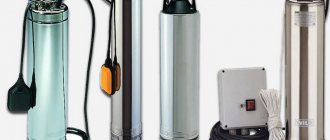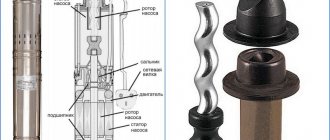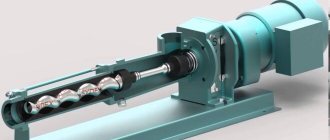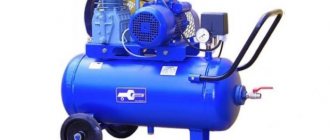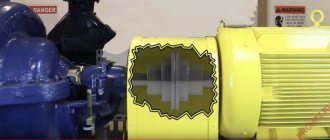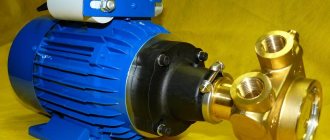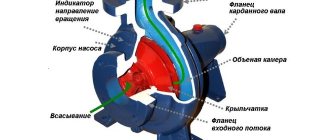If your country house has an autonomous water supply system from a well, then the presence of a pump is a prerequisite.
And if the well is very deep, then you simply cannot do without such a device as a submersible centrifugal pump.
A submersible pump for wells is a device for pumping a certain volume of liquid to the desired level.
Submersible borehole pumps are divided into vibration and centrifugal. The uniqueness of devices of this type is considered to be partial or complete immersion in water.
There are the following types - horizontal single-stage, horizontal multi-stage, fecal, dredges
Distinctive features of hand and submersible pumps
There are manual and submersible. The main difference between a submersible pump and a manual one is that a manual one is used at a depth of no more than seven meters, while a submersible one can operate at a depth of 80m.
Hand pump
It will cost much less.
For your information: If your site is located in a place where the occurrence of aquifers exceeds eight meters, then you will not be able to cope without the help of a submersible unit.
Submersible pumps
They work automatically, but to operate a manual device requires physical strength.
Submersible borehole pumps are divided into vibration and centrifugal.
Vibration type
It has a fairly simple design and is much cheaper than a centrifugal device. They are used for wells located on sandy soil, where the passage of an aquifer vein is at a depth of fifty meters.
Operating principle
Concentrated electric current creates a magnetic field. The steel core attracts and lifts the rod towards the rubber diaphragm attached to it.
Due to this, the chamber enlarges, which reduces internal pressure. This causes the container to fill with liquid. Because coil with an alternating magnetic field, the polarity changes and the core is repelled in a different direction. The liquid that gets there flows into the pipe and the inlet valve closes.
They are mainly used in wells and open sources.
The correct choice of pumping equipment is the key to uninterrupted water supply from the well. The main function of this type of pump is to lift and supply water from an artesian well.
Note: What makes devices of this type unique is partial or complete immersion in water.
Centrifugal type
The design of the centrifugal unit is made up of the following components:
- housing with high corrosion resistance;
- high power electric motor;
- motor with thermal protection;
- motor shaft;
- self-lubricating bearings;
- the impeller is represented by two plates with holes and interconnecting blades;
- suction filter to prevent various contaminants from entering the unit.
To increase water pressure, multi-stage pumping systems can be used, where water flows from one pump to another and so on until the final one. By passing through all the devices, the required pressure is gained.
The main feature of centrifugal pumps is that liquid is supplied to it constantly.
Features of choice
When purchasing a submersible device, you need to consider some nuances:
- voltage in the electrical network;
- You need to know the volume of incoming liquid. This indicator should be higher than the performance of the device. That is, the water supply must exceed the pumping of the unit. Otherwise the pump may break;
- take into account the water level of the well, the pump must be completely covered with water to avoid overheating of the engine under load;
- know at least approximately the volume of water you need;
- the device must be close in diameter to the well pipe;
- determine the time of year when the pump will be used most.
This is interesting: Water pumps for wells: types and selection rules
Advantages and disadvantages
The well pump, like other models, has its disadvantages and advantages.
The popularity of using a centrifugal unit compared to other tools for pumping water is explained by the following advantages:
- centrifugal pump is a compact device, lightweight, has a small diameter, which allows it to be used even in very narrow wells;
- the process of installation, repair and dismantling is easy; these operations can be carried out on your own without the involvement of specialists;
- a submersible centrifugal pump can be installed at any depth, even in an artesian well;
- rapid rise of water from depth due to high productivity;
- the unit operates silently, which does not create inconvenience during operation;
- the mechanism has a high degree of reliability and durability;
- water flows continuously due to the fact that the design of the unit eliminates water hammer;
- a centrifugal mechanism can be used to collect water even from a sand well, in which mechanical impurities usually form; even with high-quality maintenance, the water obtained from such a source will contain a minimal amount of sand.
Centrifugal mechanisms have disadvantages, although there are not many of them. For example, they are very sensitive to the presence of solid particles in the liquid, which can cause a malfunction. Like other units, the pump requires periodic inspection and, if necessary, repair. To do this, you have to dismantle it, take out the device, and after inspection, lower it back into place.
Varieties
On the modern market, the well centrifugal pump is represented by three main modifications:
- submersible;
- semi-submersible;
- superficial.
Submersible models
A submersible centrifugal pump looks like a small-diameter gas-filled cylinder or cylinder - the cross-sectional size of some modern models does not exceed 100 mm. Installation of such equipment is carried out directly in the well.
Submersible centrifugal pumps
The cylindrical body of the unit houses a motor with a dry-type movable rotor. To start the equipment, no additional actions are required on the part of the foreman or site owner, nor does it require filling the pump housing with water.
A submersible pump is ideal for wells with a depth of 10 m or more - in fact, in this case it has no analogue or alternative. In addition, centrifugal submersible units are universal - they can be used for constructing sand or artesian wells, as well as for pumping and transporting oily and non-aggressive acidic liquids.
When considering the purchase of equipment such as submersible pumps for wells, it should be remembered that their installation and maintenance involve the need to shut down the system and remove the equipment from the well. It is recommended to hire specialists to diagnose and repair devices of this type.
Semi-submersible units
Semi-submersible centrifugal well electric pumps operate on the same principle as a classic deep-well pump (or centrifugal submersible unit). However, there are significant differences in the design and configuration of this type of equipment. The working unit of the unit or the engine is completely protected from moisture, while the working chamber is in direct contact with it. To ensure correct operation of the semi-submersible model, it is equipped with stabilizer fins. They hold the part of the housing in which the engine is located on the surface of the water; the working part of the installation is always in the water.
Compared to submersible analogues, semi-submersible ones have less power and larger dimensions , which does not prevent them from maintaining their market positions in the corresponding segment.
Surface equipment
A surface electric pump is relevant when the depth of a well or well does not exceed 10 m. As the name implies, a surface unit is installed directly above the well, and a submersible hose is used as a contact element. Designs of this type are easy to install and maintain; the hose can also be easily removed from the well pipeline for replacement or cleaning.
Installation of a surface centrifugal pump for a well
Despite the pronounced advantages of surface pumping equipment, it also has disadvantages:
- the chamber of an old modification of the pump, which is not equipped with a check valve, needs to be filled with liquid in a timely manner (done manually), otherwise the installation will not be able to pump out a sufficient amount of water;
- The power of the installation is inferior to submersible and semi-submersible analogues.
Selection options
- volume of daily water consumption;
- the exact depth of the well or well;
- speed of filling the well pipeline with water;
- productivity (speed and volume of pumping per unit of time);
- diameter of the main well pipe;
- quality and purity of water.
Criterias of choice
When choosing a submersible pump for a well, first of all, they proceed from the main parameter of the source - the volume of supply (flow rate); if official drilling was carried out, this indicator is indicated in the passport for the well.
It should be noted that the flow rate depends on the electric pump used, so if it suits the owners, you should choose a unit with the same value. In addition, the passport provides figures for the static and dynamic level, the height of the casing and its diameter.
When carrying out drilling operations independently, determining the flow rate is not difficult - the water raised by the pump is poured into a container of known volume and the time for filling it is counted.
Surface or submersible
Due to the short distance of the aquifer from the surface of the earth and the small diameter of the casing pipes in an Abyssinian or home-made well, surface-type units are used, the suction depth of which does not exceed 9 m. Also, surface pumps into a water well can be used in artesian or sandy sources, if they static and dynamic level less than 9 m.
Typically, external water intake equipment is located in a single block called a pumping station; it includes a surface centrifugal electric pump, automation elements (relays), control devices (pressure gauge) and an expansion tank (hydraulic accumulator).
Due to the high noise during operation, the selected surface station must be placed in the basement of the house or a coffered pit; the advantages include easy access to the equipment at any convenient time.
Deep centrifugal pump for a well - design using the example of Pedrollo
Submersible pumps are used in cases where the water surface is located at a great depth; compared to surface models, they have higher characteristics, allowing several houses to be supplied with water from a high-performance artesian well, even in domestic use. They are more difficult to install and immerse in the well; this requires special heads and adapters. Since the well pump is out of sight, maintenance and monitoring of its operation is difficult.
In the absence of washing water, the submersible pump fails; if the system does not have an idle relay installed or the unit does not contain built-in protection against winding overheating, any drop in the water level below the water suction holes of the filter will lead to burnout of the electric motor.
Pump performance - determination method
As noted earlier, surface models are more effective when used at small distances of the water surface from the surface of the earth; such pumping equipment is better suited to independently constructed wells. When drilling wells yourself, there is no data on the speed at which the source is filled with water, but based on this information, the desired model of the future pump is selected. In this case, you cannot cope without an electric pump that takes water from the source, so you will have to temporarily borrow or rent it.
Vibrating submersible pump for a well - device and appearance
When determining the flow rate of a source with a surface electric pump, it is placed as close as possible to the well and the pressure pipe is immersed in water; at the output of the electric pump, the water is poured into a container of known volume, while measuring the time of its filling.
Let's say an ordinary 20 liter canister is filled in 60 seconds, converting this time into hours, we get a flow rate of 1200 liters per hour, which corresponds to the standard counting units of 1.2 cubic meters per hour. If after some time (1 hour) the water in the source drops below the level of the suction pipe and does not appear at the outlet, the electric pump is turned off and the well is given time to replenish its water reserves. A shut-off valve is installed at the outlet of the pipe from the pump and after some time the electric pump is turned on again, reducing the water flow with a tap, the presence of which is also monitored for an hour.
Thus, by means of several experimental intakes of different volumes of water, the amount of liquid per hour that can be pumped out by a well pump is determined; the technique can also be used in the case of determining the flow rate of a well with a submersible electric pump.
Lifting height - what factors to consider
A water pump in a water supply system must perform three tasks: lift water from a source, deliver it through pipes to the consumer, overcoming their hydraulic resistance, and provide the system with a given pressure for the operation of automation and home appliances (washing machines and dishwashers). It is these components that make up the formula for calculating water pressure, which will be discussed below.
Screw deep well pump - device
Immersion depth
The depth of immersion under the water surface is a passport parameter taken into account when installing a submersible electric pump; surface types are located on the ground and the data is not included in their technical characteristics. To determine the immersion depth that the selected unit should have, the static and dynamic levels are measured.
The static level is the distance from the surface of the earth to the water surface in a calm state of the source, the dynamic level is determined when an electric pump operates at depth for an hour, it is also equal to the distance from the surface of the earth to the water surface.
All measurements of water levels are made using a long dry rope with a weight, it is lowered into the well until a splash sound is heard and then the distance between the edge of the wet area and the surface of the earth is measured.
The selected submersible model must have a immersion depth in its passport specifications equal to the distance between the static and dynamic levels with a margin of 3–5 meters. This will allow the electric pump to be located far enough from the silted well bottom when using sand wells and thus improve the quality of the water taken.
Also, when the water level drops in dry weather or when the source silts up, a reserve of several meters will ensure uninterrupted operation of the electric pump. Another advantage of placing the electric pump further away from the bottom is saving money on materials and choosing a cheaper model with fewer technical requirements.
Casing parameters
Well diameter
The borehole diameter plays an important role in determining the dimensional parameters of the selected unit; it must fit into the channel with a small gap between the pipe walls. The standard diameter of manufactured submersible electric pumps is about 75 or 100 mm; for these sizes, taking into account the wall thickness, casing columns with an outer diameter of 90, 113 and 125 mm are suitable.
Installation features
When choosing a model, you need to take into account the fact that connecting a surface pump is somewhat different from installing a pump in a well.
Surface pump installation
The ease of use of surface models lies not only in the ease of fixing the unit and its connection, but also in the fact that you do not need to specifically select a location for this, since any convenient piece of land directly next to the well acts as it.
Installation diagram of a surface centrifugal pump for a well
Installation steps:
- determine the location of the equipment, level the site;
- install the pump in a position corresponding to the manufacturer’s recommendations and secure it with fasteners;
- connect the hose and check valves;
- before lowering the hose into the pipeline, make and check the connection to all communications;
- fill the pump chamber with water;
- check the functionality of the system and configure its operating parameters.
Scheme of installing a submersible pump in a well
Installation of submersible and semi-submersible pump
Despite the fact that the type of placement of a submersible and semi-submersible pump is different, their installation diagram is the same. The only difference is the need to place auxiliary support guides when installing the semi-submersible model and when placing the pump itself to prevent contact of the upper part of the housing (with the engine) with water.
Placement stages;
- inspect the pump itself, contacts and well for mechanical damage;
- install a check valve;
- connect the device to all necessary communications;
- attach a safety rope to the unit;
- perform immersion or installation in accordance with the manufacturer's recommendations;
- carry out a test run and configure the operating parameters of the installation.
Do-it-yourself selection, piping and installation of a pump in a well (video)
Final Settings
The third stage consists of final settings that allow you to adjust the operation of the entire system, the optimal pressure is checked and set, the pump itself is connected directly to the electrical network, the system is started for the first time, tested and corrected if problems are found, pipes and insulation are checked again for leaks .
If you plan to construct a well yourself, it is better not to neglect the preparatory work and seek advice from experienced and trusted specialists who have already received good reviews.
They will help you choose the best place to organize a water source, and also recommend the best pump to cope with a specific volume of liquid, and an adapter, and will also put an end to the question of the need to install a caisson and help solve many other problems, explaining the principle of operation in as much detail as possible.
Advantages and disadvantages
Let us list the main advantages of centrifugal pumps:
- High efficiency;
- Reliability in use;
- High pressure-flow properties make it possible to maintain high pressure in the water supply system with a large supply of liquid to the system;
- Possibility to install several working chambers in series or in parallel on one water supply system;
- If the operating mode of the hydraulic system changes, transient processes begin to gradually replace each other;
- The ability to smoothly regulate the power level allows you to start the device when the outlet valve or check valve is closed;
- The pumps can perform a self-priming function;
- Some device models can pump contaminated liquid containing up to 10% impurities;
- A gradual change in the functional characteristics of the device is carried out by changing the voltage in the operating network;
- Possibility of drawing a large volume of water;
- The relatively low cost of the device is ensured by the use of relatively inexpensive materials such as steel, polymers and cast iron in the development.
Disadvantages of centrifugal pumps:
- Surface models must be filled with liquid before starting;
- The phenomenon of cavitation may occur;
- Relatively low efficiency when interacting with viscous liquids;
A significant decrease in efficiency occurs with a small water supply and high pressure.
Review of popular models
Before choosing a suitable device, you should familiarize yourself with the most popular pumps for wells:
- WILO SUB TWU 4 such a device is designed for the most practical homeowners. If we consider the technical characteristics of this device, we can come to the conclusion that its high cost is absolutely justified. This brand produces many high-quality devices. WILO brand pumps can perform almost any functional task assigned to them;
- Grundfos SQ are distinguished by their high cost and reliability. Such devices are endowed with the highest technical characteristics, but their cost is still a little overpriced. A significant argument for the manufacturer in the matter of pricing can be the additional options integrated into this well pump;
- Divertron (DAB) with integrated flow and pressure sensors, can operate in automatic mode. High-quality durable materials are used for the manufacture of devices, so the duration of their operational period remains quite high;
- "Belamos". Such devices are great for arranging garden plots. All its structural elements are made of stainless steel. The pump can draw water from a depth of up to 30 meters. Depending on the specific model, the power rating of the device can vary from 3 to 7.5 kW.
This is interesting: Centrifugal water pumps: design, principle of operation, operating rules
What determines the cost of a pump?
- The most important thing in the characteristics of a pump is its technical specifications.
The engine is the heart of the pump. The cost directly depends on its type and power.- When the power increases by a difference from 0.75 to 1.5 kW, the cost increases proportionally by 4 thousand rubles.
- The stain resistance feature also affects the price. The higher the stability, the higher the price.
- Performance.
Device operation and maintenance
Before purchasing, you need to familiarize yourself with the basic rules for using and maintaining the equipment:
- The unit should not be allowed to stand idle. If the pump is immersed in a working environment, it must function continuously;
- Monitoring the condition of the unit;
- Always follow the rules outlined in the installation instructions. The permissible lowering depth and operating rules for additional equipment must be observed.
It should also be taken into account that installation of such equipment is carried out independently only if you have the appropriate skills. Otherwise, it is better to trust the installation of equipment to sufficiently qualified specialists so that subsequent operation of the pump does not involve many problems.
Recommendations for choosing equipment
Submersible pumps are made with a housing made of plastic or metal. The first option is damaged more quickly by the passage of solid particles, so its service life is relatively short. On the other hand, it is better to choose surface samples with less weight to simplify the transportation of equipment. There is also a lower level of noise emitted during operation.
Model of a submersible pump with a metal casing Source ngorod60.ru
Important criteria for choosing a drainage pump are the fraction of impurities and power. The latter determines the maximum depth of the water source. These parameters are different for all models. Submersible type samples are considered optimal, as they work better throughout the year.
Regarding productivity for the private sector, experts often focus on 180-200 liters per minute. The pressure or force of pushing the liquid out is directly reflected in the length of the connected hoses. As a rule, for every meter submerged in water there is 10 m of horizontal channel.
Purpose of the pumps
- provision of water supply to private houses;
- drainage of sewage from a private house;
- connection to the fire safety system;
- watering the site;
- pressurizing the water supply system;
- functioning of fountains, aquariums;
- filling or clearing moisture from large containers (swimming pools, basements, wells);
- creation of a “field shower”;
- spilling drinks.
Pump design: purpose and principle of operation, design diagram
About water supply and its pressure
When planning to choose a liquid pump, you need to look at its parameters. All characteristics are important, but one of the key ones is the water flow rate. It is necessary to calculate how many cubic meters of water the home owner spends per hour to find out which option is suitable.
The next, no less important characteristic is pressure. It indicates with what force the unit will supply water. This parameter is calculated according to how far the water source is from the house. The pressure is lost under the influence of height and forks in the pipeline, so it is better to provide a small margin when calculating.
Calculation of required functional characteristics
It must be understood that in the process of selecting a suitable pumping installation, many control parameters must be taken into account. The external characteristics of a device may not always matter, but this data should not be neglected either. First of all, you need to determine the appropriate pressure. For this purpose, it is necessary to summarize the sufficient height of rising liquid, as well as the distance from the well to the living space.
To be on the safe side, another 20 meters are added to the resulting coefficient. As a result, you can get a number corresponding to the required pressure indicator pumped by the well pump. You should not worry if you end up with a number of about 50-70 m. This figure is considered the minimum for a conventional borehole centrifugal pump.
The performance of the device must be taken into account. This indicator depends on the number of people living in the house, as well as the planned water consumption. For a family of 3 people and a small garden, it is enough to install a submersible pump that takes about 3 cubic meters of water per hour. This figure will have to be increased if more water needs to be extracted. Pressure and performance level are the main functional characteristics that must be taken into account when selecting centrifugal well units. Other indicators are determined on a residual basis.
Types of pumping equipment for pumping liquid media from wells
The main purpose of deep-well pumps is to pump out a liquid medium from an underground source and its further transportation through a pipeline system under a certain pressure. Hydraulic machines of this type are equipped with various systems, which, in particular, include autonomous water supply and drainage systems, irrigation systems, etc.
Depending on the scope of application, deep-well pumps can be classified as:
- devices for industrial use, which, due to their high power, are capable of lifting the liquid they pump from a depth of up to 1000 meters (such equipment is large in size and is used in various industries);
- submersible pumps for domestic use, used to ensure the efficient operation of autonomous water supply systems in country houses and cottages, as well as for the operation of irrigation systems (submersible pumps of this type are compact in size and have fairly high power).
Connection diagram for a submersible well pump
According to the installation diagram in the well, rod and rodless submersible pumps are distinguished. Devices of the second type, in particular, include pumping units with electric centrifugal pumps (ECP).
A rod pump is a hydraulic machine, the drive motor of which is located on the surface of the earth, outside the well, while only its intake part is immersed in the pumped liquid medium. The rods present in the design of such a device are designed to transmit the thrust created by the drive electric motor to the intake part.
Downhole sucker rod pumps
The drive motor of rodless pumps is located in the same housing with the intake mechanism and is immersed in the pumped liquid medium along with it. Such submersible devices are most widespread, as they are more convenient to install and operate.
Submersible pumping equipment is also divided into various types according to design and operating principle. Thus, depending on these parameters, deep-well pumps are distinguished between centrifugal and vortex, or vibration, types.
A submersible centrifugal pump is a device whose main working body is a wheel with blades mounted on a shaft rotating by an electric motor. When such a wheel (impeller) rotates, the pumped liquid located in the inner chamber, under the influence of the centrifugal force exerted on it, is thrown towards the walls of the chamber, which helps push the liquid medium into the pressure pipe. At the same time, a vacuum of air is created in the central part of the chamber, due to which a new portion of the pumped liquid is sucked from the pipe located in the well.
Downhole submersible pump "Dzhileks"
In order to prevent solid inclusions contained in the pumped liquid from entering the inside of the centrifugal submersible pump, such devices should be used in conjunction with coarse filters installed on the supply pipe. The most significant disadvantage of centrifugal pumps, which can be operated year-round, is their rather high cost when compared with the price of vortex-type equipment.
Vortex (or vibration) deep-well pumps are used in cases where water needs to be pumped out from a shallow well. The principle of operation of devices of this type is that high-frequency vibrations are created in their internal part, which drive a mechanical piston. The latter ensures the suction of the pumped medium from the supply pipe.
Vortex type borehole pump design
The most significant advantages of the pumps under consideration include:
- compact dimensions;
- low cost (compared to the price of centrifugal pumps);
- minimal power consumption.
Among the disadvantages of vortex-type submersible pumps are usually:
- destruction of the well walls from vibrations (the vibration impact of a vortex pump on the well walls can be minimized by putting rubber rings on its body);
- low power;
- rather low performance of pumping liquid medium.
Vibration pump for well “Malysh”
The best models of submersible pumps, according to the editors
As it turned out earlier, with the help of deep pumps it is possible to pump water from the deepest sources without loss of pressure. However, not all users are well versed in this type of technology. Our editors are ready to provide information about the existing most optimal models with excellent performance qualities and more.
Pump Grundfos SQ 2-85
A submersible well pump that develops high power and is capable of creating maximum pressure force. This unit can be installed horizontally and vertically. The design of the pump is intended to transport liquid exclusively in its pure form without the presence of impurities and metals.
| Power, W | Productivity, m³/hour | Device weight, kg | Head, m | Water temperature tolerance, ºС |
| 1650 | 3 | 6,2 | 109 | 35 |
Pump JILEX Poplar 3D 70/60
The pump is designed for pumping drinking water. Used for artesian springs. Such units are not recommended for use in overhead wells intended for watering gardens.
| Power, W | Productivity, m³/hour | Immersion depth, m | Head, m | Filter, mm |
| 900 | 4,2 | 80 | 60 | 1,5 |
Pump PATRIOT SP 3250S
This pump can only be operated in a vertical installation. The declared analogue is also intended for use only in conditions of perfectly clean wells.
| Power, W | Productivity, m³/hour | Weight, kg | Immersion depth | Security options |
| 750 | 1,92 | 11,2 | 80 | From dry running |
Pump BELAMOS TF3-40
Model with good performance and low noise level. The device copes with the transportation of perfectly clean water. The unit is installed in a strictly vertical position and has built-in overheating protection.
| Power, W | Productivity, m³/hour | Head, m | Immersion depth, m | Weight, kg |
| 550 | 2,7 | 42 | 80 | 9,4 |
Pump CALIBR NPTS 1.2/50
Standard submersible device, the body of which is made of stainless steel. The unit is intended for shallow wells, as it has rather weak characteristics and, accordingly, a minimum immersion depth.
| Power, W | Productivity, m³/hour | Head, m | Immersion depth, m | Pump type |
| 370 | 1,2 | 50 | 5 | Centrifugal |
Deep well pumps - design and principle of operation of submersible well pumps
In order to effectively solve problems such as pumping from great depths and supplying water to an autonomous water supply system, it is necessary to understand the design of a submersible pump for a well.
The use of such pumps makes it possible to pump water from wells whose depth reaches 80 meters.
Types of pumping equipment for pumping liquid media from wells
The main purpose of deep-well pumps is to pump out a liquid medium from an underground source and its further transportation through a pipeline system under a certain pressure.
Depending on the scope of application, deep-well pumps can be classified as:
- devices for industrial use, which, due to their high power, are capable of lifting the liquid they pump from a depth of up to 1000 meters (such equipment is large in size and is used in various industries);
- submersible pumps for domestic use, used to ensure the efficient operation of autonomous water supply systems in country houses and cottages, as well as for the operation of irrigation systems (submersible pumps of this type are compact in size and have fairly high power).
How to choose the right pump?
Pay attention to the total number of water intake points, the diameter and depth of the well, the geological features of the site, and the presence of network sources.
Important! Select a pump that exceeds the power you need.
So we figured out the design and selection of a submersible pump. Thus, using our recommendations and guided by the information received, you can choose a submersible pump that will suit you perfectly and will last a long time.
Design features of deep-well pumps
The design of a deep-well pump and its design features are largely determined by the principle of operation and the type of drive electric motor of this hydraulic machine. When using such pumps, the pumped liquid medium is collected through a special pipe placed in the shaft of the serviced well or in a well. An electric cable placed in a protective sheath is responsible for powering the drive motor, located at a certain depth.
In the design of a centrifugal type well pump, two main parts can be distinguished:
- drive motor, which can be built-in or external;
- directly the pumping part of the equipment.
Design of a centrifugal well pump
If the pump drive motor is built-in, it is usually located at the bottom of the device. Water intake when using pumps of this type can be carried out both through the upper and lower parts of their housing. In this case, preference is given to collecting the pumped liquid through the lower part of the housing, as this allows you to clean the deep part of the well from silt and sand accumulating in it. Submersible pumping devices, which is very convenient, are cooled by the liquid medium in which they are placed. This allows you to protect such devices from overheating, which can quickly render them unusable. Centrifugal-type deep-well pumps, although more complex in design than vibration devices, are characterized by higher reliability, productivity and a longer service life.
The pump suspension must withstand a load exceeding the weight of the pump by 5–10 times
The main design elements of vortex submersible pumps are a housing, a special glass, a drive motor and a vibrator. The vibrator in these devices is the most complex structural element, consisting of an armature, a rubber shock absorber and adjusting washers. The necessary conditions for drawing fluid from a well, carried out by a vibration pump, are created by its rubber shock absorber, which compresses and decompresses during operation of such a device.
A mandatory element of equipping submersible pumping equipment is a coarse filter that protects the inside of such devices from the ingress of solid impurities contained in the pumped medium. To ensure more efficient operation of submersible pumping equipment and ensure its protection from negative factors, various sensors are used that automatically stop the pump when emergency situations arise (the content of silt and sand in the pumped liquid is too high, the water level in the well decreases, etc.).
» data-lazy-type=»iframe» src=»data:image/gif;base64,R0lGODlhAQABAIAAAAAAAP///yH5BAEAAAAALAAAAAABAAEAAAIBRAA7″>
What you need to know about the well
When choosing a pump for a well or well, you need to understand some of the subtleties:
- measure the depth (distance from the surface to the bottom). We do this with a line and sinker. The device must not be lowered to a length lower than 1 m from the bottom filter;
- determine the diameter. According to this indicator, the pump will be selected. There are narrow units that will not fit into the well if its diameter is less than 130–150 mm;
- Let's find out the well's flow rate. The value will not be constant, since this indicator changes over time. It shows how many m3 of water is supplied per hour. Before installing the pumping apparatus, only drillers will be able to determine the flow rate;
- the static level of the liquid, that is, at what depth it is located if it is not pumped out. The test can be done independently using a liquid-absorbing cord and sinker;
- water level with constant intake (dynamic level). Since accurate data can only be obtained with the pump installed, it must be remembered when installing the device that the level may vary.
Classification
These devices are classified according to technical characteristics and features of use into normal-priming and self-priming. They can be with either single-stage or multi-stage equipment.
Self-priming devices can be used in liquids with a high content of gases. Their main feature is the ability to start working without liquid, while normal-absorbing ones can only work when the suction pipe is filled with water.
More common types of device data include:
- Horizontal single-stage : for liquid substances with a chemical composition similar to water;
- Horizontal multi-stage : the ability to create high pressure with a small water supply;
- Fecal : for pumping water containing polluting particles;
- Sand dredger or dredger ; works with industrial waste liquid.

